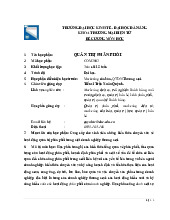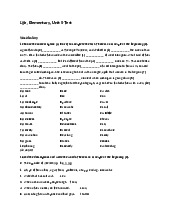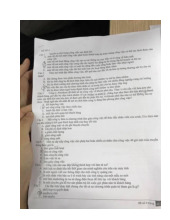















Preview text:
lOMoARcPSD| 49551302 SUMMARY OF MANAGEMENT
Management is defined as the attainment of organizational goals in an effective and efficient
manner through planning, organizing, leading, and controlling organizational resources.
Traditional management competencies could include a command-and-control leadership style, a
focus on individual tasks, and standardizing procedures to maintain stability
New management competencies include the ability to be an enabler rather than a controller,
using an empowering leadership style, encouraging collaboration, leading teams, and mobilizing for change and innovation.
The Basic Functions of Management:
+ Four fundamental management functions: - planning. - organizing. - leading. - controlling. lOMoARcPSD| 49551302 lOMoARcPSD| 49551302
An organization is a social entity that is goal-directed and deliberately structured.
Good management is important because organizations contribute so much to society.
Efficiency pertains to the amount of resources—raw materials, money, and
people—used to produce a desired volume of output.
Effectiveness refers to the degree to which the organization achieves a stated goals.
Performance is defined as the organization’s ability to attain its goals by using
resources in an efficient and effective manner. Management Skills: lOMoARcPSD| 49551302
Technical skills include the understanding of and proficiency in the performance of specific tasks.
Human skills refer to a manager’s ability to work with and through other people
and to work effectively as part of a group.
Conceptual skills are the cognitive abilities to see the organization as a whole and
the relationship among its parts. Management Types: lOMoARcPSD| 49551302
A top manager is one who is at the apex of the organizational hierarchy and is
responsible for the entire organization.
Middle managers work at the middle level of the organization and are responsible
for major divisions or departments.
A project manager is a manager who is responsible for a temporary work project
that involves people from various functions and levels of the organization.
Most new managers are first-line managers—managers who are at the first or
second level of the hierarchy and are directly responsible for overseeing groups of production employees.
A functional manager is responsible for a department that performs a single
functional task, such as finance or marketing.
General managers are responsible for several departments that perform different
functions, such as the manager of a Macy’s department store or a Ford automobile factory.
For example: I and my group 5 prepare for an essay assignment. First, we decide to
choose the leader. Second, we decide to get 8 mark . Second, we divide it into 5
parts including history of company, introducing products, calling for capital, plans
in the future and showing market. Next, we discuss about our parts on gg meet.
The leader also motivate teammates by buying junk food. CHAPTER 2:
Management Perspectives overtime: lOMoARcPSD| 49551302
Administration and Organization:
• Studying the history of management thought helps to
understand the impact of forces social quality for the organization.
• Factors affecting the approach and practice of governance: - Social force - Political forces - Economic force Classical perspectives: Scientific Management:
Improve efficiency and labor productivity through scientific methods
Frederick Winslow Taylor proposed that workers “could be retooled like machines”
Management decisions would be based on precise procedures based on study lOMoARcPSD| 49551302 Bureaucratic Organizations:
+ Max Weber, a German theorist, introduced the concepts
+ Manage organizations on impersonal, rational basis
+ Organization depends on rules and records
Managers use power instead of personality to delegate
Although important productivity gains come from this foundation,
bureaucracy has taken on a negative tone.
Administrative Principles:
The major contributor to this approach was Henri Fayol (1841–1925). lOMoARcPSD| 49551302
In his most significant work, General and Industrial Management, Fayol
discussed 14 general principles of management, several of which are part of
management philosophy today. For example: ● Unity of command. ● Division of work. ● Unity of direction. ● Scalar chain.
Humanistic Perspective:
Emphasized understanding human behavior, needs, and attitudes in the workplace. Early advocates:
+ Understand human behaviors, needs, and attitudes in the workplace
+ Mary Parker Follett and Chester Barnard
+ Contrast to scientific management - rather than Importance of people engineering techniques
+ Empowerment: facilitating instead of controlling
+ Recognition of the informal organization + Introduced
acceptance theory of authority
Human Relations Movement:
- Effective control comes from the employees themselves
- Important contributions from research at Hawthorne
- Human relations play an important role in increasing productivity
- Employees work better when managers treat them positively
- The power of human relations has had a great influence on research and - management practice. lOMoARcPSD| 49551302 Human resources perspective:
• Satisfied workers create more jobs
• Enable workers to use their full potential
− Shifting emphasis to workers' daily tasks
−Combining motivation with job design
• Maslow published the theory of hierarchy of needs
• McGregor builds Theory X and Theory Y about employee motivation. Behavioral Sciences Approach:
Scientific methods + sociology, psychology, anthropology,
economics to develop theories about behavior and interaction in
an orhumanganizational setting
Organizational development – field that uses behavioral sciences to lOMoARcPSD| 49551302 Improve organization
-Other strategies based on behavioral science: +Matrix organizations +Self-managed teams +Corporate culture
+Management by wandering around System thinking:
• The ability to see the individual elements of a situation as well as the context
scenes and the complex interactions between them • System: a collection of
related parts that act as one totality to achieve a common goal
• Subsystems (subsystems, subsystems): parts of dependent systems into each other
• Synergy (synergy): the whole is greater than the sum of its parts
• Managers must understand the interdependence and synergies of subsystems
Recent Trends: Contingency View: lOMoARcPSD| 49551302 • Every situation is unique
- Contrasted with the universal view of the classical view • Managers must
determine which method will work in each situation situation •
Managers must identify the key situational factors for the situation the situation you are facing •
Organizational structure depends on industry characteristics and other variables
Managing the People-Driven Workplace:
-The Bossless Workplace work from home
-accountability to the customers and team -Employee Engagement
emotional involvement in the job
-satisfaction with work conditions
-enthusiastic contribution to the team
For example: when our team have a presentation nextweek, we allocate the
content into 5 parts and each members will complete a part which is suitable for
their capacity. Besides , we also have rewards for people who finish it. Our purpose is motivating them. Chapter 3:
1. Define an organizational ecosystem and how the general and task
environments affect an organization’s ability to thrive. lOMoARcPSD| 49551302
- An organizational ecosystem includes organizations in all the sectors of the task
and general environments that provide the resource and information
transactions, flows, and linkages necessary for an organization to thrive.
- The general environment affects organizations indirectly. It includes social,
economic, legal-political, international, natural, and technological factors that
influence all organizations about equally. Changes in federal regulations or an
economic recession are part of the organization’s general environment, as are
shifting social attitudes toward matters.
- The task environment is closer to the organization and includes the sectors that
conduct day-to-day transactions with the organization and directly influence its
basic operations and performance.
2. Explain the strategies managers use to help organizations adapt to an
uncertain or turbulent environment.
• Strategic issues: events or pressures inside or outsidethe organization
organization has the potential to change an organization's ability to
achieve its objectives lOMoARcPSD| 49551302
• The role of cross-border connectivity: organizational alignment and
coordination actions with key factors in the external environment
- Business intelligence
−Social media analytics and big data analytics – Increasingly
important because of the rapidly changing business environment 3. Define corporate culture.
Corporate culture is the set of key values, beliefs, understandings, and
norms that members of an organization share Symbols Stories Heroes Slogans Ceremonies
4. Describe four types of corporate culture lOMoARcPSD| 49551302 •
Adaptation-oriented culture: highly responsive; value the abilityto develop
rapidly interpret, interpret, and transform signals from the environment into new behaviors •
Achievement-oriented culture: results-oriented; respect theedge
competition, dynamism, individual initiative, cost-cutting and a willingness to work
long hours long and hard to achieve results •
Culture of engagement (dedication): internally focused;featured
values that meet the needs of employees as well as cooperation and equality •
Stability-oriented culture: emphasizing stability; take thingsseriously
rules and frugality, while rewarding practices rational, methodical and orderly lOMoARcPSD| 49551302
4. Examine the relationship between culture, corporate values, and business performance.
6. Define a cultural leader and explain the tools that a cultural leader uses to
create a high-perfomance culture.
A cultural leader defines and uses signals and symbols to influence corporate
culture. The leader clarifies what the new culture should be and crafts a story
that inspires people to change. A cultural leader is the “chief marketing
officer” for the desired cultural values.81 Cultural leaders influence culture in two key areas: 1.
The cultural leader articulates a vision for the organizational culture thatemployees can believe in. 2.
The cultural leader heeds the day-to-day activities that reinforce thecultural vision. lOMoARcPSD| 49551302
7. Provide organizational examples of symbols, stories, heroes, slogans, and
ceremonies and explain how they relate to corporate culture. • Symbol: an object,
action or event with value convey meaning to others •
Story: is a narrative based on true events that arerepeated
and shared among organizational staff •
Hero : typical character that illustrates miracles, specialfeatures
and attributes of a sustainable organizational culture •
Slogan: phrase or sentence to express core valuessuccinctly the core of the organization •
Ceremonies: activities planned at a special eventusually conducted to
induce strong feelings about the values of the organization.
For example: Last week , I joined an volunteer organization which sold
flowers to make profit to help others. Due to the change of consumer’s
demands, we have to adapt by finding information from other flower shops
and analyse some social media about the common flower which people
usually buy. Moreover, we set a suitable goal to get.




